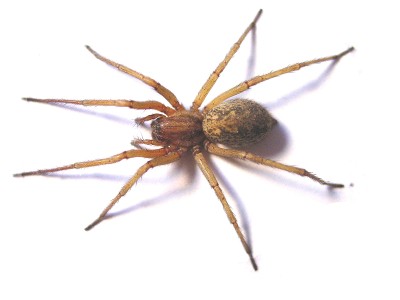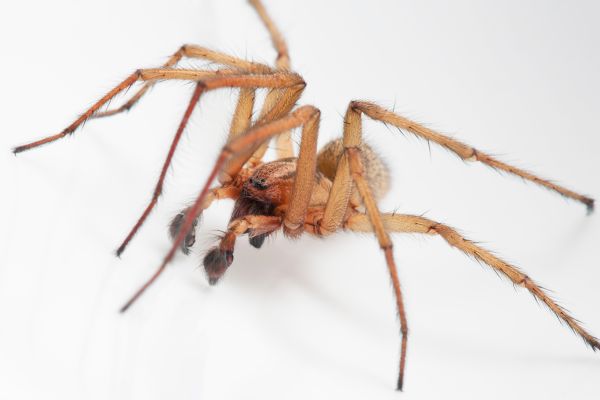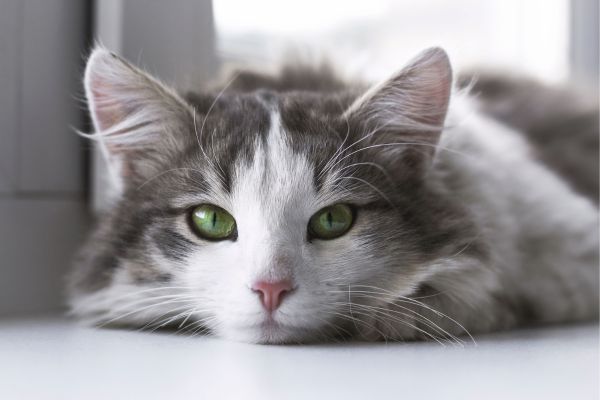Fall and early winter are prime time for spiders searching for warmer breeding grounds, and your home will do quite nicely for the randy hobo spider. Chances are, right now a male hobo spider is singing his own version of Barry White’s “Let’s Get in On” while making his way into your home in hot pursuit of a mate.
Hobos are a very common poisonous spider species in the Pacific Northwest, and we don’t want them near your curious kitty. In this article, you’ll learn:
- How to recognize a hobo spider
- The differences between the two types of hobo spider bites
- Why you should keep your cat away from hobo spiders
- Seven effective ways to control hobo spiders
How to identify a hobo spider
The hobo spider (Eratigena agrestis) is native to Europe. This large, brown spider first entered North America via the Port of Seattle between 1920 and 1930.

They weave flat, non-sticky funnel webs to catch insects and other spiders. Their webs are typically found in dark, moist areas such as basements, crawl spaces, near a home’s foundation or landscaping elements, and in woodpiles.
They are most active during the fall and spring.
- Hobo spiders are typically about the size of a quarter, from ½-inch to 1¾-inch long.
- They have a brown or gray body with two dark stripes that run parallel to each other down the middle of the abdomen.
- They have long, brown, spindly legs and a round abdomen.
- The cephalothorax (head and thorax) is wider than the abdomen.
- The eyes are arranged in a semicircle.
- There are large poison sacs near the face.
It is important to note that other spiders, such as the brown recluse and black widow, look similar to the hobo spider.
Two kinds of hobo spider bites: dry and wet
Hobo spiders have a reputation for being venomous. However, there is no scientific evidence to support this claim. In fact, the CDC (Centers for Disease Control and Prevention) does not list hobo spiders as a medically significant species.

However, hobo spider bites can still be painful and can cause some swelling and redness. In a “dry” bite, no venom is injected. Typically, these bites are painless and the victim develops only minor redness. The symptoms usually go away within a few days.
A “wet” or venomous bite is not always painful, but a small, hard area typically appears within 30 minutes, surrounded by an expanding red welt that may reach several inches in diameter. Blisters form within 15-35 hours, which eventually crust over and the tissue beneath dies (becomes necrotic). In rare cases, the bite may lead to a skin infection.
In severe cases, surgical removal of damaged tissue is required and may take months to heal, frequently leaving a permanent scar. A bite victim may also experience headaches, nausea, vomiting, and flu-like symptoms. No human deaths have been reported.
Why cats should stay away from hobo spiders
Hobo spiders are not aggressive and will only bite if they feel threatened. However, curious kitties may be tempted to play with a hobo spider, which could lead to a bite.

We don’t recommend “siccing” your cat on a hobo for spider control.
Why? Ask Dr. Monahan about the feline patient who was bitten by a hobo spider under the tongue, resulting in a large, very-slow-to-heal mouth wound.
The “wet” bites of a hobo spider are venomous, and their venom can be toxic to cats. In severe cases, a hobo spider bite can even be fatal to a cat.
If a hobo spider bites you or your cat, immediately clean the bite site with soap and water and then apply a cold compress to the area.
If the spider bites you and the bite becomes infected, you should see a doctor.
If you suspect your kitty has been bitten by a hobo spider, please contact us right away at 206.323.4433 or seek emergency veterinary care. The vet will assess the severity of the bite and provide treatment if necessary.
How to keep your cat safe from hobo spiders
- Keep your cat’s food and water bowls clean and free of debris.
- Supervise your cat when it is outdoors.
- Regularly inspect your cat’s fur for spiders.
7 effective ways to control hobo spiders
The best method of hobo spider control is to eliminate suitable habitats and allow orb weaver spiders (your typical garden spiders) to do their job.
To eliminate hobo habitats:
- Seal cracks, crevices, gaps, and openings around your windows, doors, and foundation walls. This will prevent spiders from getting inside. Repair damaged screens and install door sweeps to reduce entry points. Be sure to wear gloves and long sleeves when working in areas where hobo spiders may be present.
- Trim vegetation and remove debris, grass, leaves, and firewood from your yard, garden, and near your home’s exterior. This will minimize hiding spots.
- Reduce clutter: Spiders thrive in cluttered environments. Declutter your living spaces, particularly in basements, attics, and storage areas. Keeping your living spaces organized and clean will discourage hobo spiders from settling in.
- Vacuum and dust regularly. This will help remove spider webs and egg sacs. Pay attention to dark, moist areas and neglected areas such as corners, under furniture, and behind appliances.
- Shake out shoes and clothing before putting them on.
- Inspect toys and beds for spiders.
- Eliminate their food sources. Hobo spiders eat insects, so getting rid of any insect problems in your home will help reduce the number of hobo spiders.
Use horticultural oils or non-pesticide spider traps, found at most local hardware stores. Pesticides are not recommended for hobo control. That’s because hobo spiders are highly mobile and resistant to most pesticides, but other spider species are not. While the hobos pack up and find better air quality, pesticides kill all of their predators.
Non-pesticide spider traps have a sticky surface with an attractant in the middle. Place the traps on the floor near doors, vents, first floor windows, and stairs, following package directions regarding placement to the traps away from pets and children.
The hobo spider’s inability to move on sticky or smooth, vertical surfaces is its ultimate weakness. It falls prey to other spiders’ sticky webs and can’t get out of sinks and bathtubs after seeking a drink.
If you see a hobo spider, avoid touching it and call a pest control company if you have a serious hobo spider infestation.
Hobo spiders are not as dangerous as they are often made out to be, but their bite can cause some discomfort. It’s important to take steps to control them, especially if you have children or pets.


